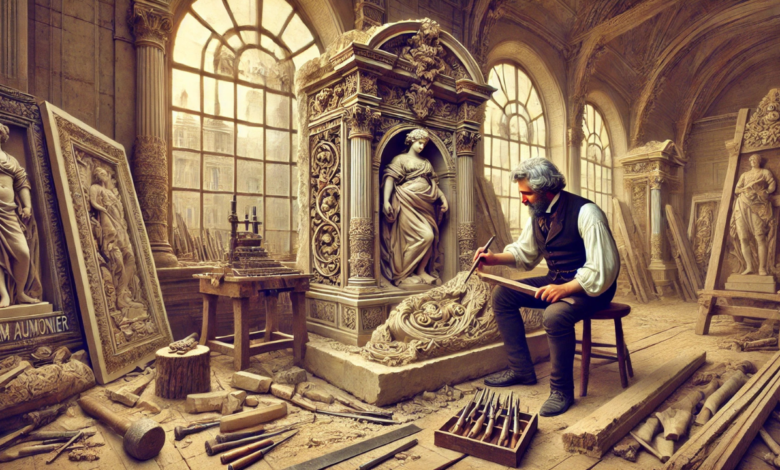
William Aumonier (1838-1903) stands as one of the pivotal figures in British genre painting, focusing on scenes of everyday life, often capturing moments of domesticity, leisure, and society. His work spans the Victorian era, a time of profound social, economic, and artistic transformation in william aumonier. Aumonier’s artistic career not only reflects the aesthetic sensibilities of his time but also offers valuable insight into the complex and changing world of 19th-century Britain. His paintings, known for their charm, detailed realism, and subtle narrative, are prominent in British art tradition.
Early Life and Training of William Aumonier
Born in London in 1838, William Aumonier was introduced to the arts at a young age. His father was also a painter, and he likely William’s early interest in the visual arts. He attended the prestigious Royal Academy schools, where he honed his skills in william aumonier, painting, and composition. While at the Academy, william aumonier gained a solid foundation in traditional techniques and classical training, serving as the bedrock for his later work.
Aumonier’s choice to specialize in genre painting was influenced by the prevailing trends in British art during the Victorian period. Genre painting, often seen as a mirror of society, was one of the most popular and revered styles during the mid-to-late 19th century. The genre painted everyday life with attention to detail and emphasized realistic portrayal, william aumonier moments from domestic life, interior scenes, or rural activities. Aumonier, like many of his contemporaries, contributed to this tradition but with a distinctive style that made his work stand out.
The Rise of William Aumonier’s Career
Aumonier made his public debut at the Royal Academy in 1861 when he exhibited his painting “The Music Lesson.” This early success marked the beginning of his long and fruitful career. Though often set in intimate, domestic spaces, his works are rich in their narrative qualities, conveying subtle emotions, social commentary, and a deep understanding of human nature. Over the years, Aumonier’s works became known for their meticulous attention to detail, particularly in capturing light, texture, and the varied complexities of human expressions.
Though Aumonier is best known for his genre scenes, he also painted historical and portrait works. However, his most memorable contributions remain firmly within the genre painting tradition. Throughout the 1860s and 1870s, he exhibited regularly at the Royal Academy, a vital platform for British artists, and he also showed works at the British Institution and the Grosvenor Gallery. Aumonier’s success was not just limited to London. His paintings found a broad audience across Britain and even abroad, where they were praised for their technical skill and engaging subject matter.
Characteristics of William Aumonier’s Art
One of the defining aspects of William Aumonier’s art is his ability to capture quiet moments of everyday life, often portraying well-to-do domestic scenes. His paintings typically depict elegant interiors like parlors, drawing rooms, and gardens. These settings are usually populated by figures engaged in leisurely pursuits, such as reading, playing music, or engaging in conversation. The figures in his work are generally shown in their finest attire, which reflects the Victorian middle and upper classes.
Aumonier’s works convey a sense of intimacy and tranquility, allowing the viewer to almost step into the scene. His careful attention to detail is evident in his depiction of clothing, furniture, and the overall ambiance of each space. The light in his paintings is also notable, with Aumonier often using natural light to highlight the subjects, further emphasizing the scene’s realism. The textures and fabrics, from the delicate folds of clothing to the intricate patterns of wallpaper and upholstery, showcase Aumonier’s skill and commitment to verisimilitude.
Despite the charm of his subjects, Aumonier’s work is not devoid of social undertones. His scenes of domestic bliss can be seen as a commentary on Victorian society’s emphasis on morality, respectability, and the role of women in the home. Through his nuanced portrayal of domestic life, Aumonier explores themes of class, gender roles, and the expectations placed on individuals within the societal framework of 19th-century Britain.
Notable Works by William Aumonier
Some of Aumonier’s most celebrated works are:
- “The Music Lesson” (1861): This is a quintessential example of Aumonier’s genre painting. It portrays a young woman receiving a music lesson. His work is characterized by careful attention to detail in the interior setting, the figures, and the soft, diffused light.
- “The Letter” (1870s): In this painting, Aumonier depicts a quiet moment where a woman reads a letter. The elegant figure and the lighting’s graceful, almost ethereal quality demonstrate Aumonier’s skill in capturing human emotions and domestic elegance.
- “The Young Musician” (1880s): Another exploration of domestic life, this painting showcases a young man at the piano. The subtle interaction between the figures and the richness of the surroundings make it one of Aumonier’s best-known works.
- “The Girl with a Parasol” (1870s): This painting, which features a young woman with a parasol in a garden, exemplifies Aumonier’s mastery of capturing the fleeting beauty of nature and the delicate figures of his subjects.
- “A Quiet Moment” (1880s): This painting, one of Aumonier’s later works, portrays a woman enjoying a peaceful moment of reflection. The composition is contemplative, with the soft light and serene setting creating an atmosphere of calm and introspection.
Influence of William Aumonier on British Art
Aumonier’s contributions to British art were part of the larger tradition of Victorian genre painting. His ability to capture social life’s nuances through art helped cement genre painting’s importance as a key genre in British art history. Though his work is often overlooked in the contemporary art world, Aumonier was highly regarded by critics and collectors during his lifetime. His work exemplified the Victorian ideals of beauty, morality, and social propriety, and his legacy continues to influence how we view Victorian-era domestic life.
The emphasis on realism and domestic themes in Aumonier’s work is part of the broader trend in British art that sought to make the private world of the home and family a central focus. By portraying figures in naturalistic settings, Aumonier contributed to the growing interest in depictions of everyday life and ordinary moments. His work was both a reflection of and a commentary on the values and ideals of the time.
William Aumonier’s Legacy
Although more famous contemporaries often overshadow William Aumonier, his contributions to British genre painting remain significant. His paintings offer a window into Victorian society, capturing the era’s elegance, propriety, and domesticity. His meticulous attention to detail, understanding of light, and ability to evoke emotion through everyday scenes have ensured that his work holds a lasting place in the history of British art.
Even today, Aumonier’s works are celebrated for their technical excellence and subtle narrative quality. Art lovers and historians continue to appreciate his unique ability to blend realism with a deep emotional resonance. His legacy lives on through his art, offering a glimpse into a bygone era that fascinates audiences worldwide.
Frequently Asked Questions (FAQs)
- Who was William Aumonier?
- William Aumonier was a British painter best known for his genre scenes depicting intimate moments of domestic life. His works were popular during the Victorian era, and he was celebrated for his attention to detail and realistic portrayal of human figures and interiors.
- What type of paintings did William Aumonier create?
- Aumonier specialized in genre painting, focusing on everyday life, domestic interiors, and social settings. His works often featured quiet, reflective moments, emphasizing light, texture, and detailed compositions.
- What was the significance of William Aumonier’s work?
- Aumonier’s work is significant for portraying Victorian domestic life, offering insights into the era’s social structures, gender roles, and values. His technical skill and focus on realism also made him a key figure in the painting tradition of the genre.
- What are some of William Aumonier’s most famous works?
- Some of his most well-known works include “The Music Lesson,” “The Letter,” “The Young Musician,” “The Girl with a Parasol,” and “A Quiet Moment.”
- How did William Aumonier influence British art?
- Aumonier’s works contributed to the tradition of Victorian genre painting by focusing on domestic life and everyday scenes. His careful attention to detail and realistic portrayals of figures and interiors influenced later developments in British art, particularly in how genre scenes were approached.
You May Also Read: https://usabestweekly.com/royme-socarras/




